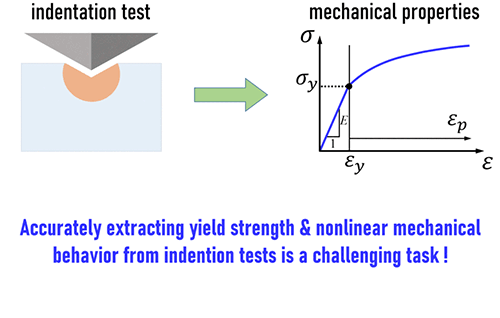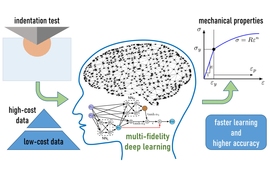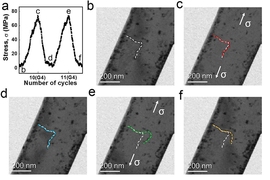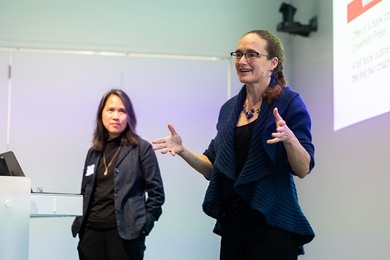A standard method for testing some of the mechanical properties of materials is to poke them with a sharp point. This “indentation technique” can provide detailed measurements of how the material responds to the point’s force, as a function of its penetration depth.
With advances in nanotechnology during the past two decades, the indentation force can be measured to a resolution on the order of one-billionth of a Newton (a measure of the force approximately equivalent to the force you feel when you hold a medium-sized apple in your hand), and the sharp tip’s penetration depth can be captured to a resolution as small as a nanometer, or about 1/100,000 the diameter of a human hair. Such instrumented nanoindentation tools have provided new opportunities for probing physical properties in a wide variety of materials, including metals and alloys, plastics, ceramics, and semiconductors.
But while indentation techniques, including nanoindentation, work well for measuring some properties, they exhibit large errors when probing plastic properties of materials — the kind of permanent deformation that happens, for example, if you press your thumb into a piece of silly putty and leave a dent, or when you permanently bend a paper clip using your fingers. Such tests can be important in a wide variety of industrial applications, including conventional and digital manufacturing (3-D printing) of metallic structures, material quality assurance of engineering parts, and optimization of performance and cost. However, conventional indentation tests and existing methods to extract critical properties can be highly inaccurate.
Now, an international research team comprising researchers from MIT, Brown University, and Nanyang Technological University (NTU) in Singapore has developed a new analytical technique that can improve the estimation of mechanical properties of metallic materials from instrumented indention, with as much as 20 times greater accuracy than existing methods. Their findings are described today in the Proceedings of the National Academy of Sciences, in a paper combining indentation experiments with computational modeling of materials using the latest machine learning tools.
The team includes co-lead and senior author Ming Dao, a principal research scientist at MIT, and senior author Subra Suresh, MIT Vannevar Bush Professor Emeritus who is president and distinguished university professor at NTU Singapore. Their co-authors are doctoral student Lu Lu and Professor George Em Karniadakis of Brown University and research fellow Punit Kumar and Professor Upadrasta Ramamurty of NTU Singapore.

Animation showing schematically the process of extracting mechanical properties from indentation tests. It is a challenging task to accurately obtain the yield strength and nonlinear mechanical behavior from indention tests. Courtesy of the researchers.
“Small” challenges beyond elasticity
“Indentation is a very good method for testing mechanical properties,” Dao says, especially in cases where only small samples are available for testing. “When you try to develop new materials, you often have only a small quantity, and you can use indentation or nanoindentation to test really small quantities of materials,” he says.
Such testing can be quite accurate for elastic properties — that is, situations where the material bounces back to its original shape after having been poked. But when the applied force goes beyond the material’s “yield strength” — the point at which the poking leaves a lasting mark on the surface — this is called plastic deformation, and traditional indentation testing becomes much less accurate. “In fact, there's no widely available method that's being used” that can produce reliable information in such cases, Dao says.
Indentation can be used to determine hardness, but Dao explains that “hardness is only a combination of a material’s elastic and plastic properties. It's not a ‘clean’ parameter that can be used directly for design purposes. … But properties at or beyond yield strength, the strength denoting the point at which the material begins to deform irreversibly, are important to access the material’s suitability for engineering applications.”
Technique demands smaller amounts of high-quality data
The new method does not require any changes to experimental equipment or operation, but rather provides a way to work with the data to improve the accuracy of its predictions. By using an advanced neural network machine-learning system, the team found that a carefully planned integration of both real experimental data and computer-generated “synthetic” data of different levels of accuracy (a so-called multifidelity approach to deep learning) can produce the kind of quick and simple yet highly accurate data that industrial applications require for testing materials.
Traditional machine learning approaches require large amounts of high-quality data. However, detailed experiments on actual material samples are time-consuming and expensive to conduct. But the team found that doing the neural network training with lots of low-cost synthetic data and then incorporating a relatively small number of real experimental data points — somewhere between three and 20, as compared with 1,000 or more accurate, albeit high-cost, datasets — can substantially improve the accuracy of the outcome. In addition, they utilize established scaling laws to further reduce the number of training datasets needed in covering the parameter space for all engineering metals and alloys.
What’s more, the authors found that the majority of the time-consuming training process can be done ahead of time, so that for evaluating the actual tests a small number of real experimental results can be added for “calibration” training just when they’re needed, and give highly accurate results.

Animation illustrating the key features and advantages of the novel “multi-fidelity” deep learning method. Courtesy of the researchers.
Applications for digital manufacturing and more
These multifidelity deep-learning approaches have been validated using conventionally manufactured aluminum alloys as well as 3-D-printed titanium alloys.
Professor Javier Llorca, scientific director of IMDEA Materials Institute in Madrid, who was not connected with this research, says, “The new approach takes advantage of novel machine learning strategies to improve the accuracy of the predictions and has a large potential for fast screening of the mechanical properties of components manufactured by 3-D printing. It will allow one to discriminate the differences in the mechanical properties in different regions of the 3-D-printed components, leading to more accurate designs.”
Professor Ares Rosakis at Caltech, who also was not connected with this work, says this approach “results in remarkable computational efficiency and in unprecedented predictive accuracy of the mechanical properties. ... Most importantly, it provides a previously unavailable, fresh pair of eyes for ensuring mechanical property uniformity as well as manufacturing reproducibility of 3D-printed components of complex geometry for which classical testing is impossible.”
In principle, the basic process they use could be extended and applied to many other kinds of problems involving machine-learning, Dao says. “This idea, I think, can be generalized to solve other challenging engineering problems.” The use of the real experimental data helps to compensate for the idealized conditions assumed in the synthetic data, where the shape of the indenter tip is perfectly sharp, the motion of the indenter is perfectly smooth, and so on. By using “hybrid” data that includes both the idealized and the real-world situations, “the end result is a drastically reduced error,” he says.
The work was supported by the Army Research Laboratory, the U.S. Department of Energy, and the Nanyang Technical University Distinguished University Professorship.












